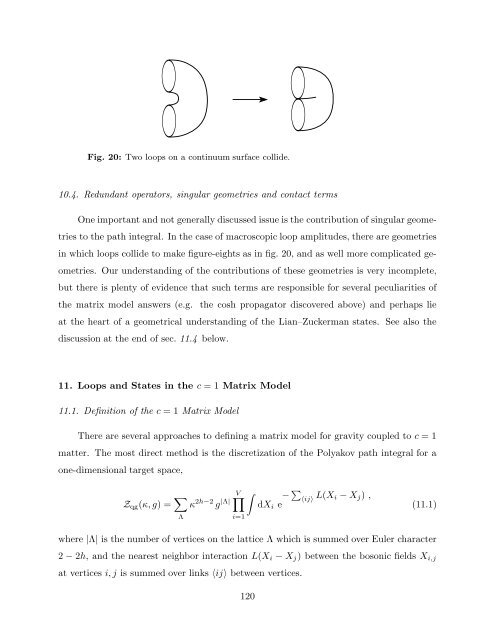arXiv:hep-th/9304011 v1 Apr 5 1993
arXiv:hep-th/9304011 v1 Apr 5 1993
arXiv:hep-th/9304011 v1 Apr 5 1993
You also want an ePaper? Increase the reach of your titles
YUMPU automatically turns print PDFs into web optimized ePapers that Google loves.
Fig. 20: Two loops on a continuum surface collide.<br />
10.4. Redundant operators, singular geometries and contact terms<br />
One important and not generally discussed issue is <strong>th</strong>e contribution of singular geometries<br />
to <strong>th</strong>e pa<strong>th</strong> integral. In <strong>th</strong>e case of macroscopic loop amplitudes, <strong>th</strong>ere are geometries<br />
in which loops collide to make figure-eights as in fig. 20, and as well more complicated geometries.<br />
Our understanding of <strong>th</strong>e contributions of <strong>th</strong>ese geometries is very incomplete,<br />
but <strong>th</strong>ere is plenty of evidence <strong>th</strong>at such terms are responsible for several peculiarities of<br />
<strong>th</strong>e matrix model answers (e.g. <strong>th</strong>e cosh propagator discovered above) and perhaps lie<br />
at <strong>th</strong>e heart of a geometrical understanding of <strong>th</strong>e Lian–Zuckerman states. See also <strong>th</strong>e<br />
discussion at <strong>th</strong>e end of sec. 11.4 below.<br />
11. Loops and States in <strong>th</strong>e c = 1 Matrix Model<br />
11.1. Definition of <strong>th</strong>e c = 1 Matrix Model<br />
There are several approaches to defining a matrix model for gravity coupled to c = 1<br />
matter. The most direct me<strong>th</strong>od is <strong>th</strong>e discretization of <strong>th</strong>e Polyakov pa<strong>th</strong> integral for a<br />
one-dimensional target space,<br />
Z qg (κ, g) = ∑ Λ<br />
κ 2h−2 g |Λ|<br />
V ∏<br />
i=1<br />
∫<br />
dX i e − ∑ 〈ij〉 L(X i − X j ) ,<br />
(11.1)<br />
where |Λ| is <strong>th</strong>e number of vertices on <strong>th</strong>e lattice Λ which is summed over Euler character<br />
2 − 2h, and <strong>th</strong>e nearest neighbor interaction L(X i − X j ) between <strong>th</strong>e bosonic fields X i,j<br />
at vertices i, j is summed over links 〈ij〉 between vertices.<br />
120
















